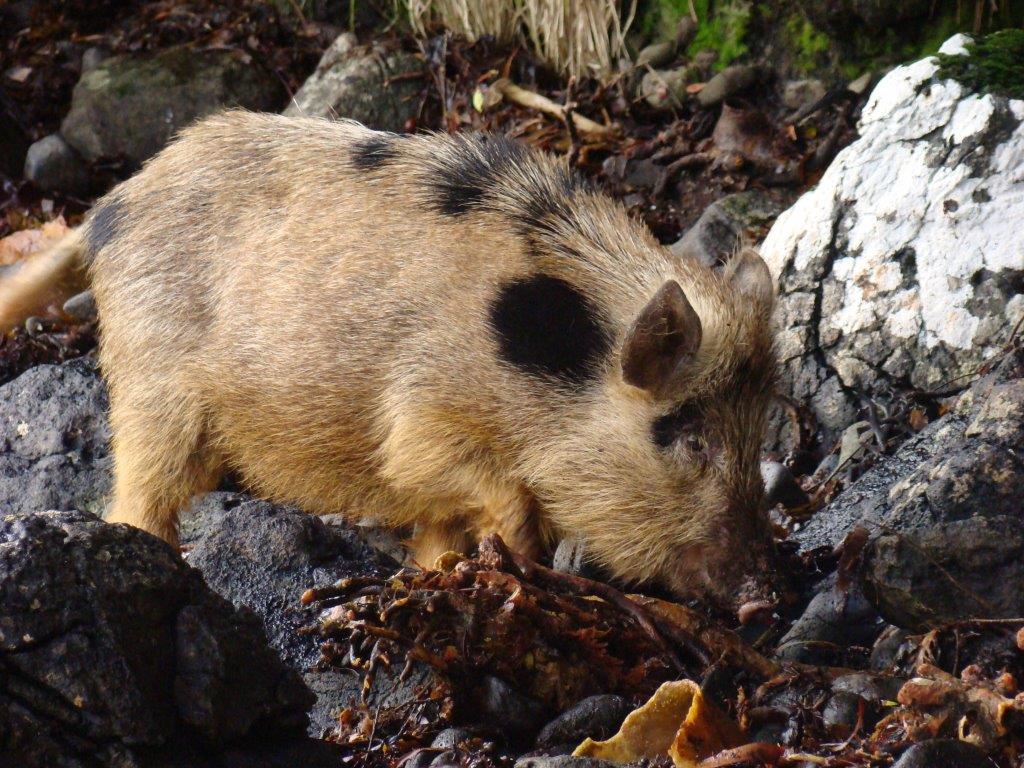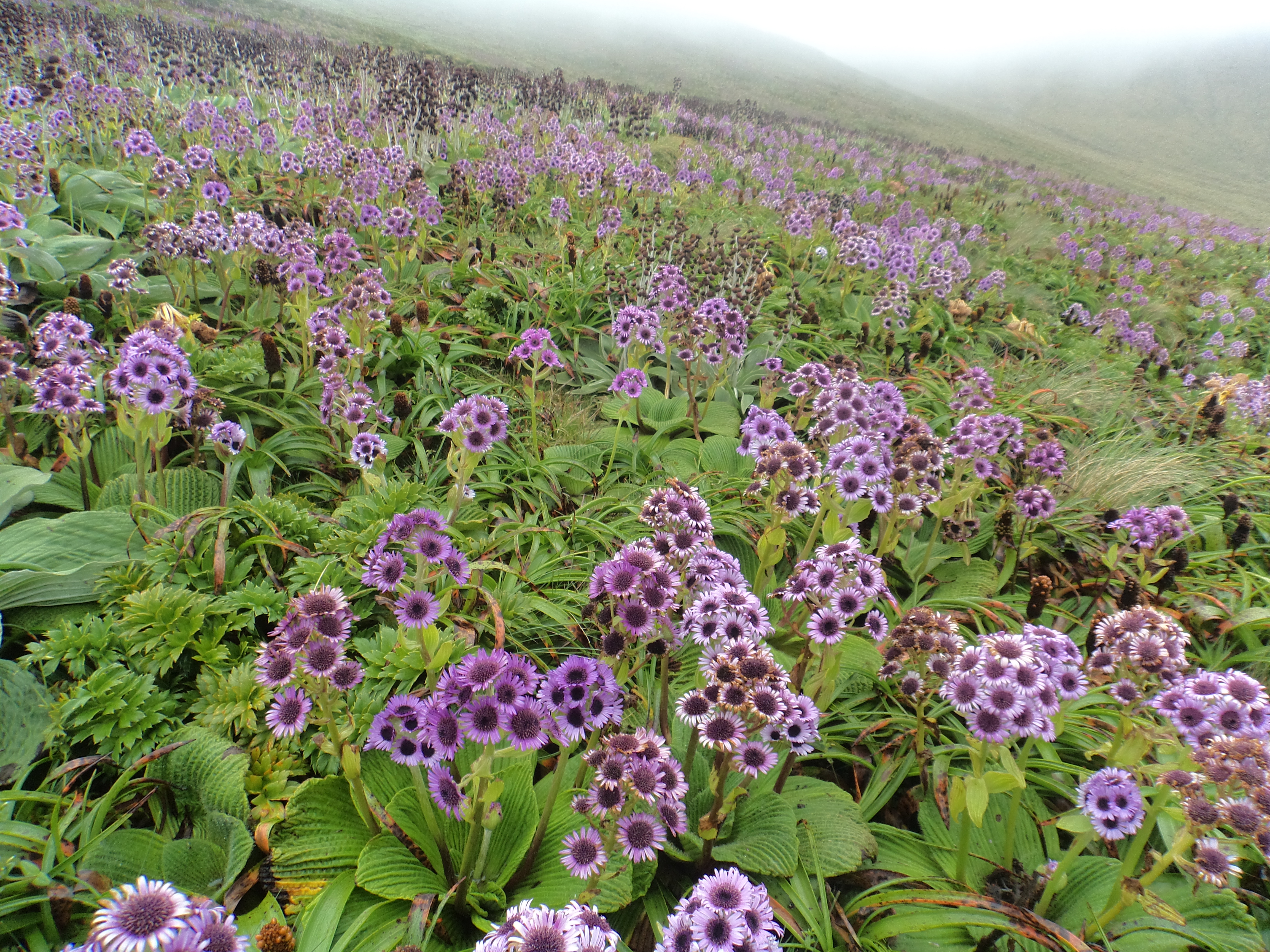
The Million Dollar Mouse project works towards its ultimate success as a bait bucket is loaded at last light on Antipodes Island; photograph by Keith Springer
Note: In this guest article, Keith Springer, Operations Manager for South Africa’s Mouse-Free Marion Project, writes about a suite of publications in a special issue of the New Zealand Journal of Ecology on the restoration of New Zealand’s sub-Antarctic islands. A Table of Contents with linked titles and lead authors follows his article.
******************************
For many years now, New Zealand has put significant effort and resources into managing pest animal species on its sub-Antarctic islands. There are five main groups, Antipodes Island, Auckland Islands, Bounty Islands, Campbell Island and The Snares, that together form the New Zealand Sub-Antarctic Islands World Heritage Site. The Bounty Islands and The Snares have never had introduced mammals establish on them — they have remained animal pest-free.

A rare breed in the cross hairs? A feral pig forages among washed-up kelp along the shore on Auckland Island; photograph by Pete McClelland
The other three island groups all had numerous species of introduced mammal established. This occurred for several reasons. Some animals established either from shipwrecks or from stowaways in the stores and equipment brought by the first European visitors – the sealers and whalers of the early 19th Century. This typically included rats, mice, cats, and sometimes, dogs. Because the islands lay on the ‘Great Circle’ shipping route – in the days of sail, ships bound from Australia to England sailed these latitudes to pick up the prevailing westerly winds – shipwrecks were common (the location of Auckland Islands being incorrectly marked on the charts didn’t help). As a result, animals like goats, pigs and rabbits were introduced so that shipwrecked sailors might find sustenance. Finally, the government let grazing leases on some islands, so cattle and sheep were taken there as part of farming operations.
Over the years, the sealing and whaling industries collapsed, steam ships replaced sail, so the Great Circle Route fell into disuse and the grazing leases were cancelled. However, the animals remained, and diminished the biodiversity values of the islands by eating seabirds, land birds, invertebrates and by grazing the vegetation. The sum of these impacts was a significant deterioration of the ecological condition of those islands with introduced pests.

A globally Endangered Antipodean Albatross Diomedea antipodensis feeds its chick on Antipodes Island; photograph by Keith Springer
From the 1980s, the then-New Zealand Wildlife Service set about trying to address these impacts, although a paper in the Proceedings of the New Zealand Ecological Society of 1968 had discussed this strategy earlier. The ungulates were the easiest to remove, with sheep, cattle and goats eradicated by shooting campaigns. With the establishment of the Department of Conservation in 1987 this work continued, with European Rabbits and House Mice removed from two smaller islands in the Auckland group. Small by our standards now, that is, but ground-breaking efforts at that time. This momentum saw Campbell Island cleared of Norway Rats in 2001, which has been the inspiration for many pest eradications on islands in the Southern Ocean ever since, notably on Macquarie and South Georgia (Islas Georgias del Sur)*. House Mice were removed from Antipodes Island in 2016, and planning has been underway for some time to consider removal of mice, pigs and cats from 45 891-ha Auckland Island. If accomplished, this would remove the last invasive mammal species from all the island groups in the World Heritage Site.
An immense body of knowledge and experience has been built up in the roughly 35 years of eradication activity on these islands, and each has informed and refined methodology for the next – not only in the New Zealand region, but on islands throughout the Southern Ocean.

Now, a special edition of the New Zealand Journal of Ecology collates information in 19 open-access papers on topics relating to many of these eradications on the New Zealand sub-Antarctic islands (the Campbell rat and Antipodes mouse eradications have been published elsewhere). The edition also reports on other island eradications in New Zealand that were partly conducted as trial projects to inform the planned mouse eradication on Auckland Island, or that informed other aspects of the multi-species eradication planned for Auckland Island, such as potential methods for cat eradication on Stewart Island. There is also a paper describing the introduced mammals that were brought back to New Zealand so that populations of these genetically isolated breeds could be maintained. After all, most of the ungulates and lagomorphs on these islands had descended from genetic bloodlines that existed up to 200 years ago and have been isolated from others of their species ever since.
Of particular interest is the number of papers regarding the eradication of mice, including several where different bait application rates were trialled. As noted, mouse eradication was achieved on Antipodes Island and may be attempted on Auckland Island, following some years of research and planning. The planned eradication on Marion Island by the Mouse-Free Marion Project is certainly ambitious but undertaking this on Auckland Island – 50% larger than Marion – would be an even greater challenge, especially given the complexities caused by the presence of cats, pigs and large areas of scrub and forest.
A special-topic journal issue such as this one really does crystalise just how much has been achieved in the eradication of mammalian pests from sub-Antarctic islands. Of even greater importance, it also describes the ends to which eradication is the means; that is - the ecological recovery that results from these management interventions.
Keith Springer, Operations Manager, Mouse-Free Marion Project, 22 December 2022
New Zealand Journal of Ecology, Volume 46(3), 2022
Table of Contents
Editorial: Restoration of New Zealand subantarctic islands by James Russell et al.
The eradication of Campbell Island sheep and subsequent ecological response by Derek Brown et al.
The hunting-assisted demise of Campbell Island cattle by Derek Brown et al.
The eradication of cattle from Enderby Island and subsequent ecological response by Derek Brown et al.
The eradication of feral goats from Auckland Island by Derek Brown et al.
Introduction, rescue, and subsequent history of Auckland Islands livestock by Michael Trotter et al.
Eradication confirmation of mice from Antipodes Island and subsequent terrestrial bird recovery by Stephen Horn et al.
Analysis of spatiotemporal patterns of home range use and habitat selection to inform management of feral pigs on Auckland Island by Dean Anderson et al.
A local eradication pilot study of methods for feral pig eradication on Auckland Island by Finlay Cox et al.
Use of automatic feeders to attract feral pigs on Auckland Island by Finlay Cox & Norm Macdonald
A field test of the anaesthetics, surgical methods and radio-transmitters required for producing Judas pigs for an eradication programme by Kate McInnes et al.
Spatial ecology meets eradication of feral cats on Auckland Island by Mariano Rodriguez-Recio et al.
Monitoring and detection of feral cats on Auckland Island by Alistair Glen et al.
Field palatability and degradation of a selection of feral cat bait matrices on Auckland Island by Finlay Cox et al.
Feral cats on Rakiura Stewart Island: population attributes and potential eradication tools by Alistair Glen et al.
Population trends of house mice during tussock mast seeding on Auckland Island by Rachael Sagar et al.
How low can you sow? House mouse eradication on Motuareronui/Adele Island by James Livingstone et al.
A trial on Te Pākeka/Maud Island for reducing aerial baiting sow-rates for the eradication of house mice by Emmanuel Oyston et al
The next frontier: assessing the feasibility of eradicating mammalian pests from Auckland Island by Stephen Horn et al.
*A dispute exists between the Governments of Argentina and the United Kingdom of Great Britain and Northern Ireland concerning sovereignty over the Falkland Islands (Islas Malvinas), South Georgia and the South Sandwich Islands (Islas Georgias del Sur y Islas Sandwich del Sur) and the surrounding maritime areas.

 English
English  Français
Français  Español
Español